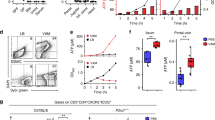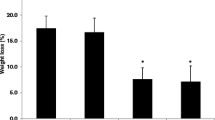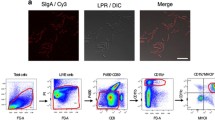Abstract
The development of allergy is related to differences in the intestinal microbiota. Therefore, it is suggested that the immune responses induced by different genera of bacteria might be regulated through adaptive as well as innate immunity. In this study, we examined whether antigen-specific immune responses were affected by stimulation with the different genera of intestinal bacteria in vitro. Mesenteric lymph node (MLN) cells isolated from germ-free ovalbumin (OVA)-specific T cell receptor transgenic (OVA-Tg) mice were stimulated with OVA and intestinal bacteria. Cecal contents from conventional mice but not germ-free mice could induce OVA-specific cytokine production. Among the murine intestinal bacteria, Bacteroides acidofaciens (BA) enhanced OVA-specific IFN-γ and IL-10 production while Lactobacillus johnsonii (LA) increased OVA-specific IL-10 production only. The expression of cell surface molecules and cytokine production by antigen-presenting cells (APCs) from germ-free Balb/c mice were analyzed. BA increased the expression of MHC II and co-stimulatory molecules on APCs compared with LA. BA increased IL-6 and IL-10 production but induced less IL-12p40 than LA. To examine the effects of prior stimulation of APCs by intestinal bacteria on the induction of antigen-specific immune responses, cytokine production was determined following co-culture with OVA, CD4+ T cells from OVA-Tg mice, and APCs which were pre-stimulated with the bacteria or not. APCs pre-stimulated with LA did not enhance OVA-specific cytokine production while BA stimulated OVA-specific IL-10 production. These results suggest that the prior stimulation of intestinal immunocytes by Lactobacillus might regulate excessive antigen-specific cytokine responses via APCs when compared with prior stimulation by Bacteroides.






Similar content being viewed by others
Abbreviations
- APCs:
-
Antigen-presenting cells
- BA:
-
Bacteroides acidofaciens
- DCs:
-
Dendritic cells
- LA:
-
Lactobacillus johnsonii
- LPS:
-
Lipopolysaccharide
- LTA:
-
Lipotechoic acid
- Mϕs:
-
Macrophages
- MLN(s):
-
Mesenteric lymph node(s)
- OVA:
-
Ovalbumin
- OVA-Tg:
-
OVA-specific T cell receptor transgenic
- PAMPs:
-
Pathogen associated molecular patterns
- PGN:
-
Peptidegrycan
- PRRs:
-
Pattern recognition receptors
- TLRs:
-
Toll-like receptors
References
Ahrne S, Nobaek S, Jeppsson B, Adlerberth I, Wold AE, Molin G (1998) The normal Lactobacillus flora of healthy human rectal and oral mucosa. J Appl Microbiol 85:88–94
Bjorksten B, Naaber P, Sepp E, Mikelsaar M (1999) The intestinal microflora in allergic Estonian and Swedish 2-year-old children. Clin Exp Allergy 29:342–346
Chen Y, Song K, Eck SL (2000) An intra-Peyer’s patch gene transfer model for studying mucosal tolerance: distinct roles of B7 and IL-12 in mucosal T cell tolerance. J Immunol 165:3145–3153
Christensen HR, Frokiaer H, Pestka JJ (2002) Lactobacilli differentially modulate expression of cytokines and maturation surface markers in murine dendritic cells. J Immunol 168:171–178
Drakes M, Blanchard T, Czinn S (2004) Bacterial probiotic modulation of dendritic cells. Infect Immun 72:3299–3309
Fujioka M, Hachimura S, Hosono A, Nakamura R, Hirayama K, Itoh K, Kaminogawa S (2004) Establishment and analysis of germfree T cell receptor transgenic mice. Anim Cell Technol: Basic & Appl Aspects 13:243–247
Hessle C, Andersson B, Wold AE (2000) Gram-positive bacteria are potent inducers of monocytic interleukin-12 (IL-12) while gram-negative bacteria preferentially stimulate IL-10 production. Infect Immun 68:3581–3586
Itoh K, Mitsuoka T (1985) Characteriazation of clostridia isolated from faeces of limited flora mice and their effect on caecal size when associated with germ-free mice. Lab Anim 19:111–118
Itoh K, Mitsuoka T, Sudo K, Suzuki K (1983) Comparison of fecal lactobacilli in mice of different strains under different housing conditions. Z Versuchstierkd 25:193–200
Kabelitz D (2007) Expression and function of Toll-like receptors in T lymphocytes. Curr Opin Immunol 19:39–45
Kaisho T, Takeuchi O, Kawai T, Hoshino K, Akira S (2001) Endotoxin-induced maturation of MyD88-deficient dendritic cells. J Immunol 166:5688–5694
Kaisho T, Hoshino K, Iwabe T, Takeuchi O, Yasui T, Akira S (2002) Endotoxin can induce MyD88-deficient dendritic cells to support T(h)2 cell differentiation. Int Immunol 14:695–700
Kalinski P, Hilkens CM, Wierenga EA, Kapsenberg ML (1999) T-cell priming by type-1 and type-2 polarized dendritic cells: the concept of a third signal. Immunol Today 20:561–567
Kalliomaki M, Kirjavainen P, Eerola E, Kero P, Salminen S, Isolauri E (2001) Distinct patterns of neonatal gut microflora in infants in whom atopy was and was not developing. J Allergy Clin Immunol 107:129–134
Kononen E, Jousimies-Somer H, Asikainen S (1992) Relationship between oral gram-negative anaerobic bacteria in saliva of the mother and the colonization of her edentulous infant. Oral Microbiol Immunol 7:273–276
Mazmanian SK, Liu CH, Tzianabos AO, Kasper DL (2005) An immunomodulatory molecule of symbiotic bacteria directs maturation of the host immune system. Cell 122:107–118
Nakajima-Adachi H, Ebihara A, Kikuchi A, Ishida T, Sasaki K, Hirano K, Watanabe H, Asai K, Takahashi Y, Kanamori Y, Shimojo N, Matsuda H, Kohno Y, Hachimura S, Kaminogawa S (2006) Food antigen causes TH2-dependent enteropathy followed by tissue repair in T-cell receptor transgenic mice. J Allergy Clin Immunol 117:1125–1132
Park SH, Itoh K (2005) Species-specific oligonucleotide probes for the detection and identification of Lactobacillus isolated from mouse faeces. J Appl Microbiol 99:51–57
Pasare C, Medzhitov R (2004) Toll-dependent control mechanisms of CD4 T cell activation. Immunity 21:733–741
Raymond CR, Wilkie BN (2005) Toll-like receptor, MHC II, B7 and cytokine expression by porcine monocytes and monocyte-derived dendritic cells in response to microbial pathogen-associated molecular patterns. Vet Immunol Immunopathol 107:235–247
Sato S, Takeuchi O, Fujita T, Tomizawa H, Takeda K, Akira S (2002) A variety of microbial components induce tolerance to lipopolysaccharide by differentially affecting MyD88-dependent and -independent pathways. Int Immunol 14:783–791
Shida K, Hachimura S, Ametani A, Ishimori M, Ling M, Hashiguchi M, Ueda Y, Sato T, Kumagai Y, Takamizawa K, Habu S, Kaminogawa S (2000) Serum IgE response to orally ingested antigen: a novel IgE response model with allergen-specific T-cell receptor transgenic mice. J Allergy Clin Immunol 105:788–795
Snel J, Bakker MH, Heidt PJ (1997) Quantification of antigen-specific immunoglobulin A after oral booster immunization with ovalbumin in mice mono-associated with segmented filamentous bacteria or Clostridium innocuum. Immunol Lett 58:25–28
Umesaki Y, Setoyama H, Matsumoto S, Imaoka A, Itoh K (1999) Differential roles of segmented filamentous bacteria and clostridia in development of the intestinal immune system. Infect Immun 67:3504–3511
Wang Q, McLoughlin RM, Cobb BA, Charrel-Dennis M, Zaleski KJ, Golenbock D, Tzianabos AO, Kasper DL (2006) A bacterial carbohydrate links innate and adaptive responses through Toll-like receptor 2. J Exp Med 203:2853–2863
Werling D, Hope JC, Howard CJ, Jungi TW (2004) Differential production of cytokines, reactive oxygen and nitrogen by bovine macrophages and dendritic cells stimulated with Toll-like receptor agonists. Immunology 111:41–52
Acknowledgments
We thank Dr. Sonoko Habu and Dr. Takehito Sato (Tokai University, School of Medicine) for generously providing the TCR-transgenic mice.
Author information
Authors and Affiliations
Corresponding author
Rights and permissions
About this article
Cite this article
Tsuda, M., Hosono, A., Yanagibashi, T. et al. Prior stimulation of antigen-presenting cells with Lactobacillus regulates excessive antigen-specific cytokine responses in vitro when compared with Bacteroides . Cytotechnology 55, 89–101 (2007). https://doi.org/10.1007/s10616-007-9104-1
Received:
Accepted:
Published:
Issue Date:
DOI: https://doi.org/10.1007/s10616-007-9104-1




